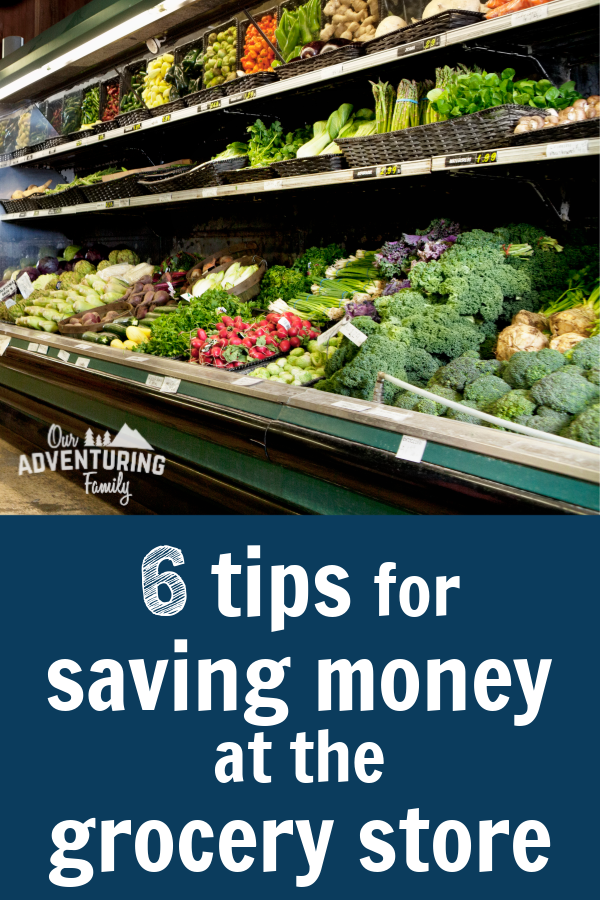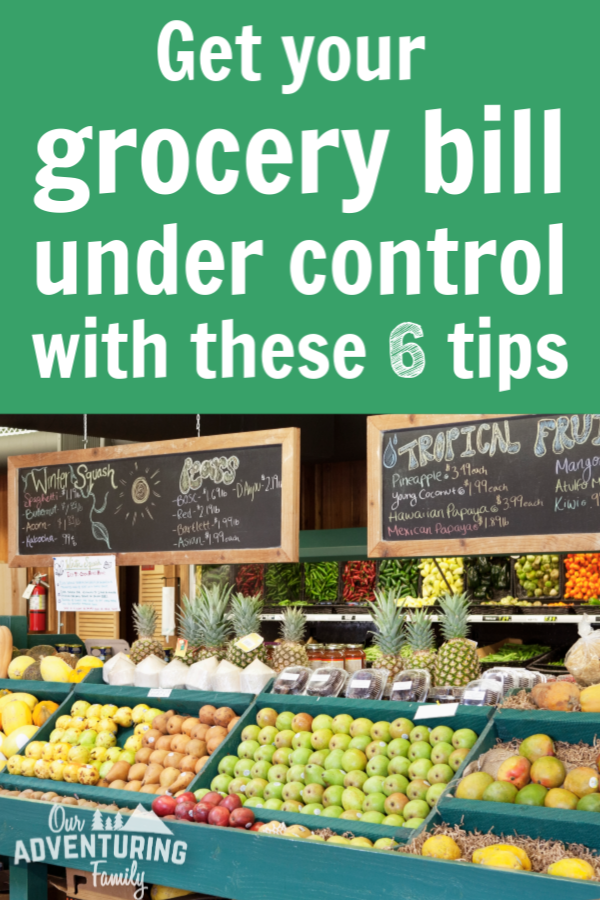This post may contain affiliate links. As an Amazon Associate I earn from qualifying purchases, but there is no additional cost for you. Please see my Disclosure page for more information.
Right now a lot of people are looking for ways to cut expenses and live within tighter budgets. The pandemic has wreaked havoc on jobs, budgets, and our sense of normalcy. If you’re dealing with this, or just want to cut down on waste, here’s some tips to help you save money at the grocery store.
Now, I’m not going to tell you to buy the cheapest foods and cut out all your favorite foods. In fact, our food budget is a bit higher than I’d like, but it’s because we’re choosy about the quality of the meat, eggs, and milk that we buy. My chronic health conditions dictate that we eat as healthily as possible, and it’s not the cheapest way to eat. It’s all about priorities.
We have a few chickens that we got a few months ago, but until that point we’d purchase pastured eggs from a local farmer or the grocery store. We get raw milk from a local dairy, and we buy pastured meats from local farms as well as in the grocery store, when we can find it.
More and more small farms are selling their meat products online, especially with the current supply chain issues. If you’re interested, some farms to check out include: Five Marys Farms, 1915 Farm, Ballerina Farm, and Polyface Farm. There’s even apps such as WhatsGood to help you find local meat and produce. It’s farmers market season and some have started offering online ordering with in-car pickup.
While we do buy locally when we can, the majority of our food still comes from the grocery store. Keep reading for how we keep those costs under control.
6 Ways to Save Money at the Grocery Store
1. Know your food budget and stick to it
Do you know what your food budget is? (if you need help getting your budget under control, check this post out) Set a budget before you leave the house and then stick to that budget. But it’s super easy to go over your budget as you’re walking through the store, adding items to your cart. Here’s a couple tips to keep track of your spending while you’re at the store:
- Keep a running tally in the store. I tally up prices on my calculator (use your phone calculator app to do it incognito) as I add items to my cart. I jot down totals periodically and add up those totals to make sure I’m staying under budget. It may take you back to the days of eating on a super-tight college student budget to shop with a calculator (anyone else?), but it was useful then, and it’s useful now for making sure you stay within budget.
- If you shop at different stores, split up your budget between those stores and keep a running total as you shop at each.
If you don’t know exactly what your food budget is, this may take a couple shopping trips to fine tune. Don’t stress about it. It’s a constantly evolving process since prices fluctuate seasonally.
2. Only shop every two weeks
Fewer visits to the store means less money spent. We get paid twice a month, so I go shopping on the first Monday after payday. (this is just what works for my schedule, YMMV) I hit up 3-4 stores and get all the shopping done in a couple hours.
However, while we’ve been staying home, Jeremy is our designated errand runner while the rest of us stay home. I dislike going shopping and will put off trips unless they’re really needed. Jeremy, on the other hand, has no problem running to the store for a couple things (and bringing back more than intended). Our food expenditures have increased with the changes to our shopping patterns.
3. Meal plan so you can make a shopping list
Since we only shop every two weeks ideally, that means we have to meal plan for those two weeks. I then use that meal plan to make our shopping list. We keep things simple, with basic ingredients that can be used in multiple meals. Elaborate meals or meals with that one expensive ingredient don’t have a place in the meal plan right now.
I’m not saying you need to eat rice and beans every night for dinner (I actually can’t eat them because that many carbs has a negative impact on my chronic illnesses), but there’s nothing wrong with adding them into the rotation once a week or once every two weeks. Of course, if you find you like them, eat them more often. Your budget will thank you!
Try to stick with meals you know the kids/spouse/whoever else you live with will eat. This will reduce food waste and wasted money. Bonus points if you those meals are on the cheaper side. For example, if your kids love pasta, there’s lots of ways to make pasta, and it’s cheap and filling.

4. Go digital
I usually use Kroger’s Clicklist order pickup service. This saves me time in the store, and I’m able to check the frig and pantry as I’m placing my order. This helps me avoid buying ingredients we already have or forgetting ingredients we do need. Even better, since we stick to a pretty basic menu and shopping list, they have a category called “My Recent Purchases” that allows you to quickly add the items you purchased last time to your cart.
We do pay a $4.99 pickup fee, but we more than save that much by avoiding impulse buys in the store. Kroger also has digital coupons that you can clip as you add items to your shopping cart. No more cutting paper coupons from the newspaper! (do people even buy the paper anymore?)
With the advent of sheltering in place, I discovered that Shipt will deliver Target and Walgreens orders to our home. Instacart won’t deliver to us (so no Costco or restaurant deliveries), but Whole Foods will deliver using their Amazon local delivery network (before they got that up and running, they wouldn’t deliver to us).
I’ve been pleasantly surprised by these discoveries as we live in a fairly rural county and haven’t been eligible for a lot of the delivery services I’ve investigated in the past. I think it does help that our rural county is right next door to a decent size city and county. My point? Even if you live in a rural location, it wouldn’t hurt to look into delivery services again. You may discover that some will now work for you as well.
Be sure to consider the cost of pickup/delivery services + tips versus impulse buys (Target, I’m looking at you!). Shipt does have an annual fee (use this link for $10 off that annual fee), but if you place just one order a month, you’ll be saving money over the usual one-time delivery fees. It’s easy to over-spend at Target, but even when factoring in the delivery fee and tip, I’m still spending less than when I shop in store.
5. Have a designated shopper
Designate the person least likely to impulse buy as the shopper for your household. In our family, that person is me. Normally I do all the shopping because I’m more conscious of the budget and less likely to add items to the shopping cart (Target is a bit of an outlier, so I try to limit my Target runs 😉).
I also try to do the shopping alone, since the kiddos and Jeremy like to add things to the cart that aren’t on the shopping list.
As I mentioned up in #2, Jeremy is currently our designated shopper since he still goes to work a couple days a week. It has affected our food budget, which reinforces why it’s normally a good idea for me to do the shopping. I am still able to do the online orders, but some shopping has to be done in person.
On the flip side, doing the big shopping has made him more conscious of how much we spend every paycheck on food. In the past he’s only run to the store for one or two items that were forgotten, so he wasn’t as aware of our overall spending. Seeing the number on paper is different from seeing the total at the register and handing over your debit card.
Anyone who’s ever shopped with kiddos knows that they make it super easy to go off budget. Sometimes it’s because they’re indiscriminately grabbing packages off the shelf that you don’t discover until you check out. Other times you’re just trying to keep them calm and quiet, so you can get this done as soon as possible. It can be challenging, to say the least.
If I do have to take one or more kiddos shopping, I’ve found that setting behavior guidelines and expectations beforehand helps. So does bribery. We don’t eat a lot of candy, but I will totally hold a $1 box of candy over my kiddos’ heads to get them to not ask for anything, stay close, and not whine. And there have been times when they haven’t gotten their candy. You can’t be afraid to follow through, even when there’s tears in public.
6. Bulk buy, but only when it will save money
Not all bulk buys are beneficial for the budget. But we’ve found that certain items are cheaper at Costco than other stores, and we use them up before they go bad. If that wasn’t the case, it wouldn’t be worth the cost per item savings.
We also use Amazon Prime Subscribe and Save for some bulk items. Prices do fluctuate, but we’ve found that for the items we buy, it’s cheaper for us to buy them in bulk through S&S. If we order 5 or more items at a time, we receive a 15% discount on each of the items. Winning! If your order contains less than 5 items, you’re still eligible for a 5% discount on each item.
If you’ve never used Subscribe and Save, you build your order and the items are delivered once a month. You can adjust the frequency, amount, and so on. I will skip my S&S order if we haven’t finished everything from the previous order or if we don’t have 5 items in our order yet. I’m always aiming for that 15% discount!
Some of our current favorites that I order through Subscribe and Save include YumEarth gummy bears (the kids’ favorite treat while hiking), Nuun electrolyte tablets (I like the fruit punch flavor, and it’s so much better than Gatorade), and Epic meat bars (bison cranberry bacon is the best!).
~~~~~
What tips do you have for keeping your grocery bill under control?


